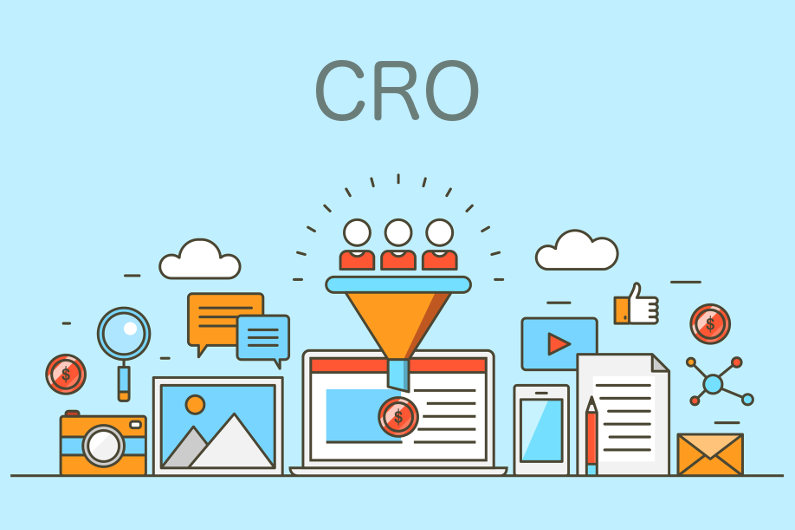A website is a key marketing tool for every business. Making sure it’s fully effective is important for your business. And conversion rate optimisation, better known as CRO, is crucial to make sure your site maximises its full business potential.
Whether you run an ecommerce business, or your company profits rely heavily on how customers use your company website, this article explains why CRO can be an essential business marketing activity.

Explaining conversion and CRO
Before explaining CRO, it’s important to first discuss conversion. This is about completing an action, which is the ultimate goal of your website. You might have traffic coming to your business site, but this won’t be your ultimate goal. If you run an ecommerce business, for instance, it will probably be for your customers to buy a product on your site. But, depending on your business, it could also be to get a user to make an enquiry, or sign up to your newsletter, or download an app.
The conversion rate is the percentage of a site’s total traffic that completes an ultimate goal. So the higher the conversion rate, the better. Conversion rate optimisation is about getting more users to complete that goal. Digital marketing website Econsultancy describes it as “the process of optimising your site to increase the likelihood that visitors will complete that specific action.”
How CRO works
The process of CRO is about understanding your website visitors, optimising their experience and influencing their behaviour. All this is done to ultimately make your business more efficient and profitable. For an ecommerce business, this might involve using research and data to inform changes on its website to get people to buy even more of its products.
But this shouldn’t be concerned with making big, dramatic changes to a business website. Making CRO effective is more about keeping things simple. As US media company Forbes explains, conversion rate optimisation is about simplicity.
This is not to say CRO is simple. It’s anything but, involving a lot of research, data collecting and testing to determine how users use a website. It’s more about having a mindset that simple is better. If there’s less clutter on a web page of your site which has a specific action, for instance, more people are more likely to carry out that action and convert.
Changes to suit your customers
Why it’s important to keep things simple can be demonstrated with the menu of a takeaway restaurant, which is distributed to customers. Regular customers feel comfortable with this menu and can quickly work their way around it. They know the selection of dishes it covers, what they cost, and have an idea of the level of service they’ll receive when ordering from the menu.
But what would happen if that menu was completely redesigned, and it was given a new layout with new images and a logo? How would those same customers feel about something that was once comfortable and familiar to them? Their ideas of value, service and quality could be challenged by this new menu, for instance. They might even start thinking about trying another takeaway to see what it offers instead.
This shows how CRO should be about making simple changes to improve a user’s journey when using a website, and finding the right changes to maximise potential. It is not about making a huge sweeping change and hoping for the best. Like in this case, big changes could prove negative, challenge how customers feel about your business, and turn them away.

Multiplying your revenue potential
To better understand how CRO can make your business profitable, you should consider the idea that it can significantly optimise the way you generate revenue. For example, imagine you run an ecommerce site that brings in 1000 customers a year. Each customer spends £10 per order and orders four times a year, which gives a baseline of £40,000 in revenue. If you were to spend your efforts increasing your customers by 20%, you would get 1200 customers, giving you an £8000 uplift in revenue.
But imagine if you increased everything by 20%, so you have 1200 customers, each spending £12, five times a year. This would give you £72,000 – a £32,000 revenue increase from the original £40,000 baseline. This is what CRO can do. It can create a multiplier effect by taking all of your marketing efforts and making them work even harder.
One real life example of how financially effective CRO can be is shown from travel agency Sunshine.co.uk. At a time when the travel industry was in crisis, the company used agency Conversion Rate Experts in 2010 to increase its site conversion. Consequently, it almost doubled Sunshine’s conversion rate in six months, compared with 2009. This made the travel company an extra £14 million in one year.
Using CRO in your business
When using CRO to improve how your company website performs, you should carry out different processes to help make it more effective. For instance, you should consider having someone act as the voice of your key customers. This should be someone who actively engages with your customer base and understands it. It’s better to do this than to make changes based on your assumptions and viewpoints alone, or those of your senior staff or upper management, depending on how your business is structured.
You should also utilise your research, act on data and insight, and don’t ignore what it tells you. It’s wise to also have an experimental culture and be prepared to test every detail of your site, and the different user journeys your customers take. That way you can see what works, what doesn’t, and what could work better to help make more of your customers complete your ultimate site goals.


